Designing a Raised Bed Garden in the Desert Southwest
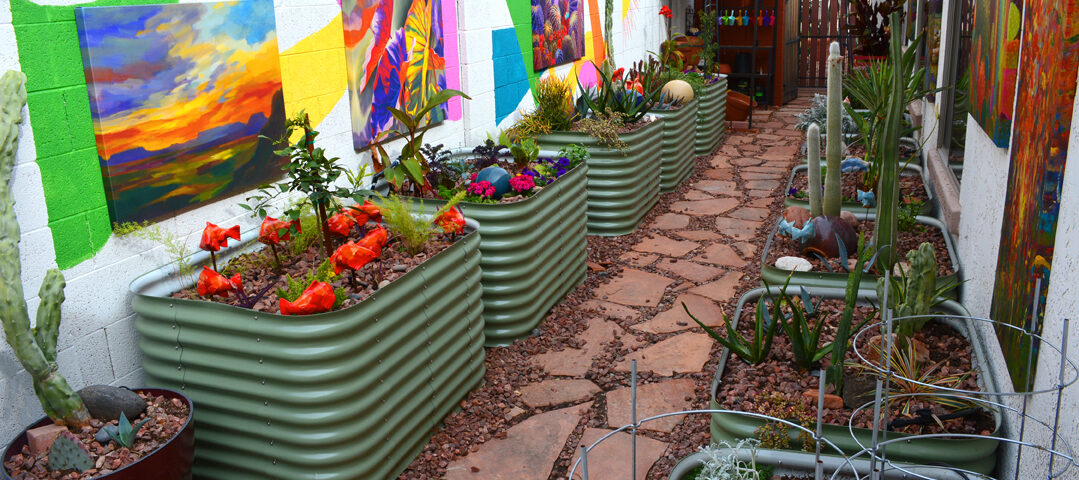
[Photo credit Shawna Coronado]
Creating a garden in the desert southwest offers unique opportunities to combine beauty, productivity, and conservation. Designing a raised bed garden in this region ensures fruits, vegetables, and herbs thrive despite the arid climate. With the right strategies, you can craft an ornamental yet functional space that supports sustainable living.
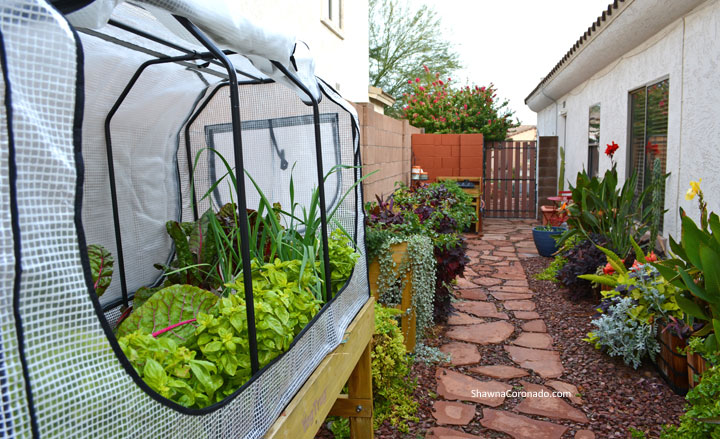
Why Raised Bed Gardens Work in the Desert Southwest
Raised beds offer numerous advantages, particularly in challenging climates like the desert southwest. Elevated structures improve soil quality, provide better drainage, and help regulate temperatures. These benefits are critical for growing healthy, productive plants in this region.
Raised beds also allow gardeners to optimize water usage. By concentrating irrigation and using techniques like drip systems, you’ll conserve water and ensure it reaches plant roots efficiently. The elevated design can deter pests and weeds, further reducing the maintenance needed for your garden.
Planning Your Raised Bed Garden
- Choose the Right Location: Sunlight is key for fruits, vegetables, and herbs. Most plants require at least six to eight hours of direct sunlight daily. Observe your yard throughout the day to identify the sunniest spots. In the desert southwest, providing some afternoon shade can prevent heat stress during the scorching summer months. Using shade cloths or planting taller crops on the west side of your beds can shield smaller plants from intense sunlight.
- Design for Functionality and Beauty: Arrange your beds to create a cohesive flow that complements your outdoor space. Symmetrical layouts or artistic designs, such as spiral patterns, can add a touch of creativity. Using materials like natural stone, metal, or wood to construct your raised beds can blend seamlessly with the desert aesthetic. Pathways of gravel or pavers make the garden accessible and visually striking.
- Determine the Size and Depth of Beds: Beds that are four feet wide or less allow easy access from both sides. Depths of 12 to 18 inches are ideal for most crops, as they provide ample space for root development. For deep-rooted plants like carrots or tomatoes, consider beds at least 18 inches deep. Shallower beds work well for herbs and leafy greens.
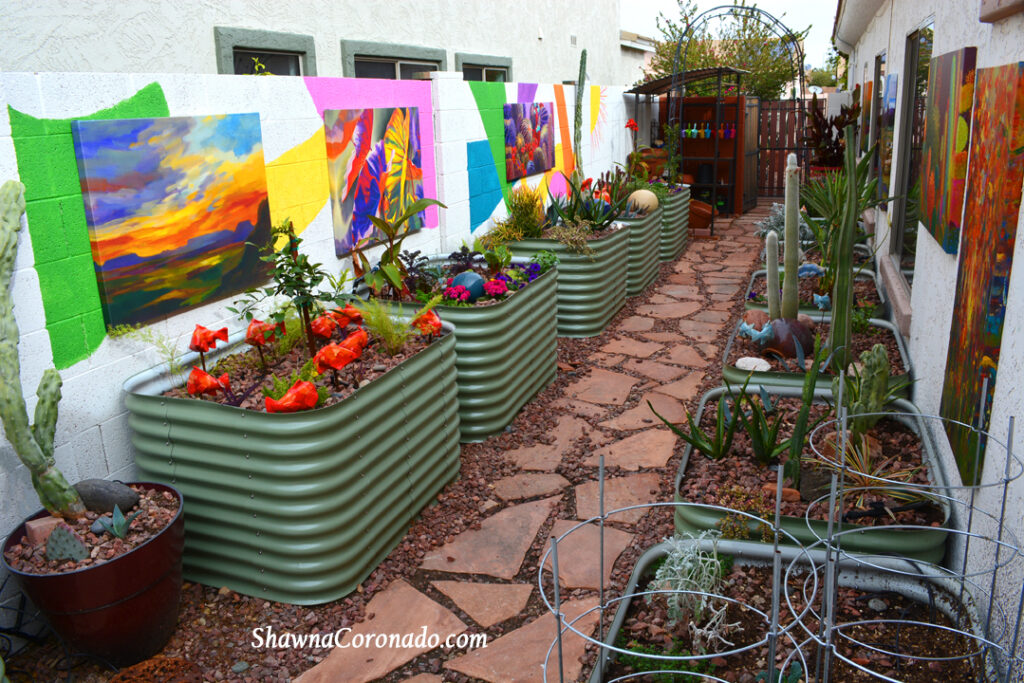
Preparing the Soil
Soil quality determines the success of your raised bed garden. Desert soils often lack organic matter and nutrients, making amendments crucial.
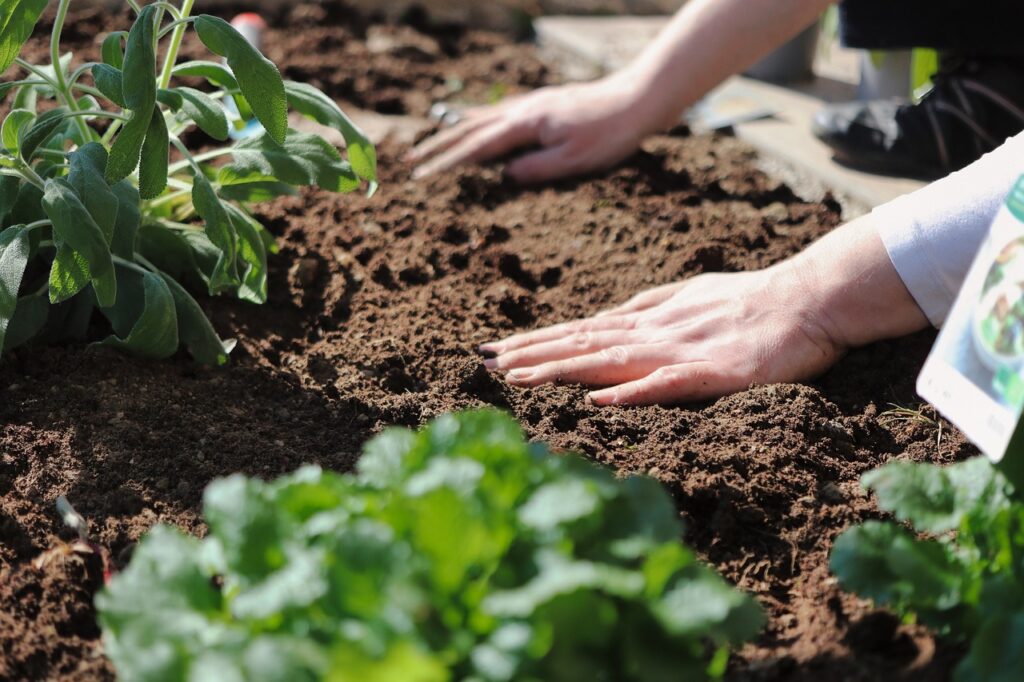
Using a high-quality soil mix is essential. Fill your raised beds with a mix of potting soil, compost, and organic matter. A good ratio is 25% potting soil, 75% compost. However, if you are less concerned over holding moisture and more concerned that your specific plants need dryer roots, consider a formula of 50% potting soil, 30% compost, and 20% coarse sand or perlite for drainage. This combination retains moisture while ensuring proper aeration.
Incorporating organic matter enriches the soil with nutrients. Compost, aged manure, or worm castings improve soil structure, helping it retain water and nutrients effectively. Testing and adjusting soil pH can also make a big difference. Many desert soils are alkaline, which can hinder nutrient uptake. Adjust the pH to a slightly acidic range of 6.0 to 7.0 using amendments like sulfur or peat moss if needed.

Choosing Plants for Your Raised Bed Garden
Selecting the right plants ensures your garden thrives in the desert’s unique climate. Focus on heat-tolerant, drought-resistant varieties that flourish with minimal water. Here are some excellent options:
- Fruits:
- Cantaloupes: Sweet and easy to grow in hot climates.
- Figs: Thrive in full sun and tolerate drought conditions.
- Pomegranates: Ideal for arid regions and produce vibrant fruit.
- Grapes: Heat-tolerant varieties like ‘Flame Seedless’ flourish in the desert.
- Dates: Perfect for Mediterranean climates with extreme heat.
- Vegetables:
- Tomatoes: Heat-tolerant varieties like ‘Phoenix’ or ‘Solar Fire.’
- Peppers: Including bell peppers, jalapeños, and chilies.
- Squash: Such as zucchini and yellow squash, which grow quickly and abundantly.
- Sweet potatoes: Thrive in hot conditions and produce nutritious tubers.
- Okra: Well-suited for extreme heat and minimal water.
- Herbs:
- Basil: Thrives in sunny spots with regular watering.
- Thyme: Adaptable to dry conditions and full sun.
- Oregano: Performs well in the desert and requires little maintenance.
- Rosemary: Tolerates heat and drought, making it an ideal choice.
- Sage: Another hardy herb that excels in arid climates.
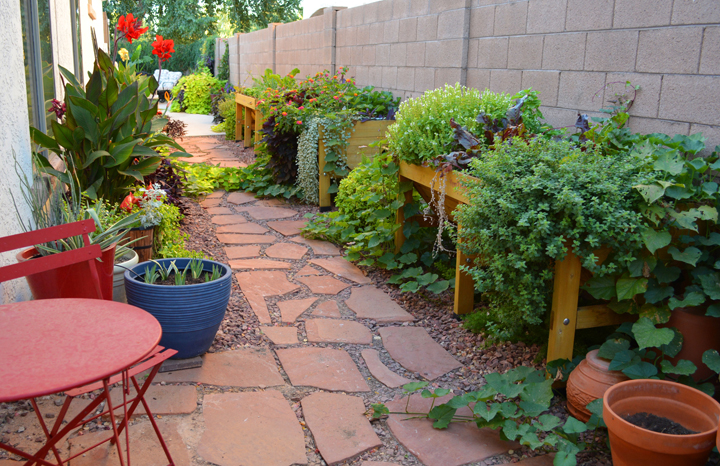
Watering Strategies
Efficient watering is essential in the desert southwest. Raised beds dry out faster than traditional in-ground gardens, so a consistent watering plan is crucial. When designing where the raised beds will go on your property, consider existing irrigation and how you will connect the gardens with irrigation lines.
Installing drip irrigation delivers water directly to plant roots, minimizing waste. Automating watering schedules with timers ensures consistent moisture levels. Adding mulch helps retain moisture, keeps soil temperatures stable, and suppresses weeds. Organic mulch, such as wood chips or straw, is particularly effective. Watering early in the morning or late in the evening reduces evaporation and prevents plants from wilting during the hottest part of the day.
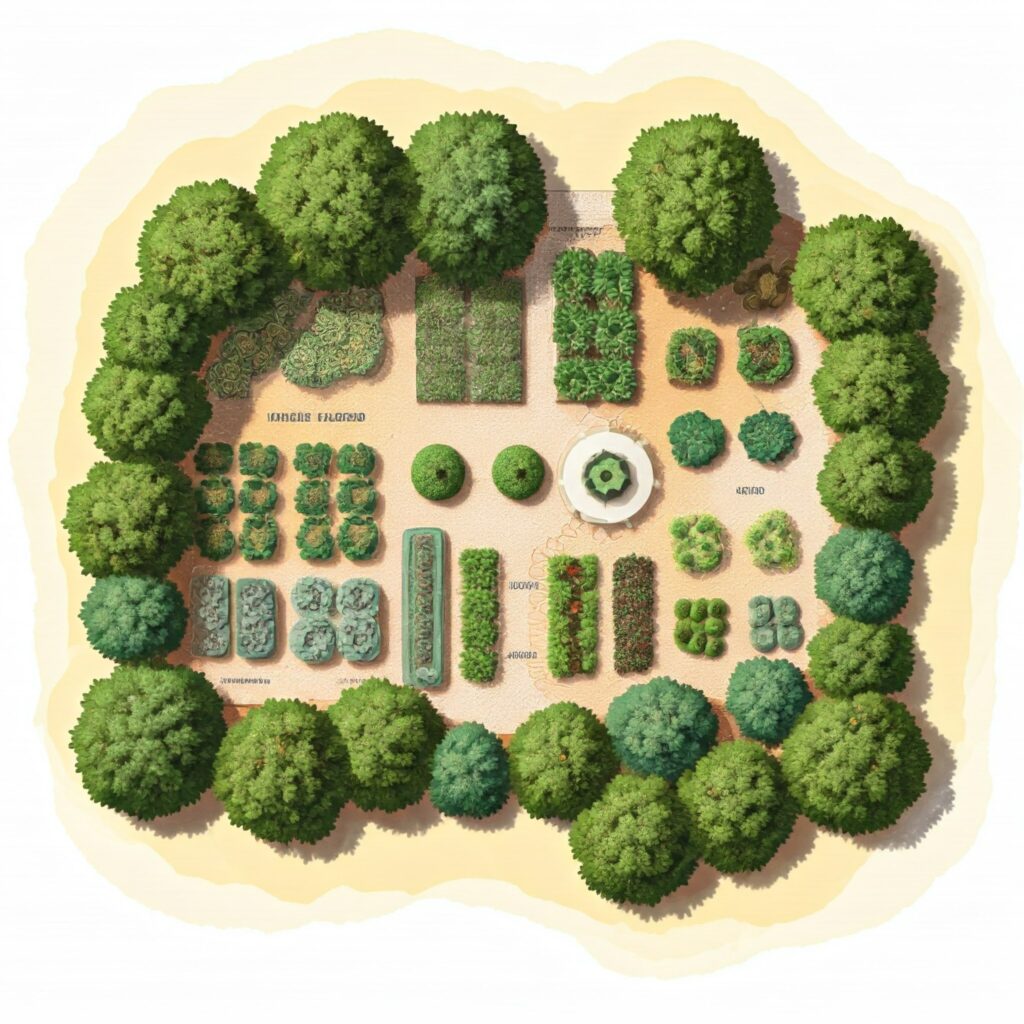
Incorporating Conservation Techniques
Conservation is vital when gardening in the desert southwest. Harvesting rainwater by installing rain barrels can collect and store water during rare desert rains. This water can be used to irrigate your garden during dry periods. Integrating native plants like desert marigold or agave around your raised beds minimizes water usage and attracts pollinators, supporting a thriving ecosystem. Constructing raised beds from recycled or repurposed materials, such as old bricks, cinder blocks, or reclaimed wood, adds character to your garden while reducing waste.
Maintaining Your Raised Bed Garden
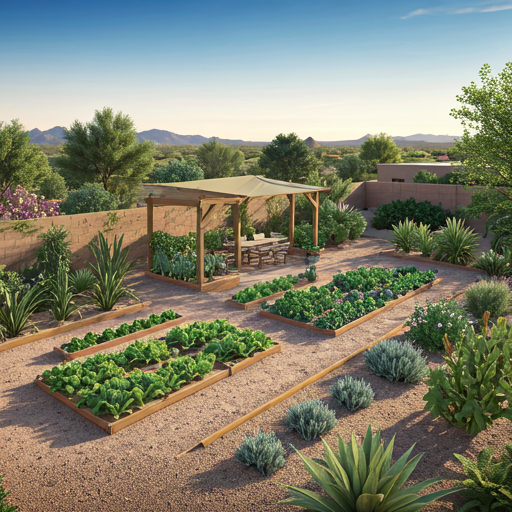
A well-maintained garden stays healthy and productive year-round. Regular weeding prevents competition for water and nutrients. While raised beds often have fewer weeds, regular checks are essential. Seasonal planting helps maintain soil health and prevent pests. For example, following tomatoes with legumes replenishes nitrogen in the soil. Monitoring for pests like aphids or caterpillars is also crucial. Organic pest control methods, such as neem oil or companion planting, can protect your crops effectively.
Conclusion
Designing a raised bed garden in the desert southwest combines practicality, beauty, and sustainability. By following these tips, you can create an ornamental edible garden that is very elegant and thrives in the harsh climate. Focus on efficient water use, soil preparation, and selecting the right plants to ensure success. With thoughtful planning and maintenance, your raised bed garden will provide fresh fruits, vegetables, and herbs while enhancing your outdoor space.
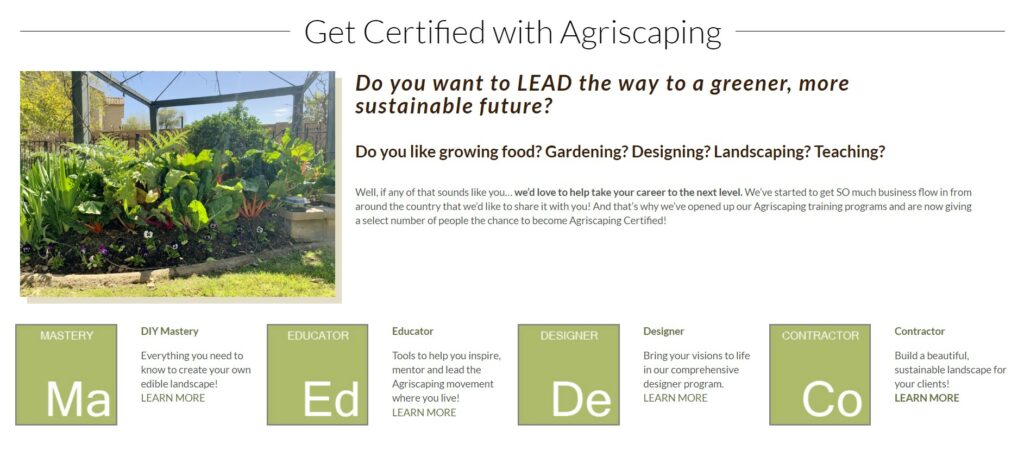
Read Our Latest Posts…
- Subterranean Trampoline Gardens: A Hidden Oasis for Growing and Playing
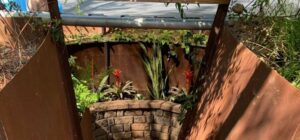 Expert tips for desert gardening, from plant zoning and efficient irrigation to soil care and agriscaping for a sustainable landscape.
Expert tips for desert gardening, from plant zoning and efficient irrigation to soil care and agriscaping for a sustainable landscape. - 7 Elegant Edible Flowers To Be Thankful For
 Expert tips for desert gardening, from plant zoning and efficient irrigation to soil care and agriscaping for a sustainable landscape.
Expert tips for desert gardening, from plant zoning and efficient irrigation to soil care and agriscaping for a sustainable landscape. - Top 10 Winter Wonders: Beautiful and Edible Flowers for the Cool Season
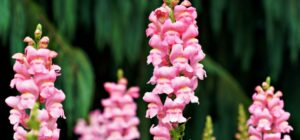 Expert tips for desert gardening, from plant zoning and efficient irrigation to soil care and agriscaping for a sustainable landscape.
Expert tips for desert gardening, from plant zoning and efficient irrigation to soil care and agriscaping for a sustainable landscape. - Create Your Own “Farmacy” with Healing and Aromatic Herbs
 Expert tips for desert gardening, from plant zoning and efficient irrigation to soil care and agriscaping for a sustainable landscape.
Expert tips for desert gardening, from plant zoning and efficient irrigation to soil care and agriscaping for a sustainable landscape. - The Power of Healthy Soil: Where Wellness Begins
 Expert tips for desert gardening, from plant zoning and efficient irrigation to soil care and agriscaping for a sustainable landscape.
Expert tips for desert gardening, from plant zoning and efficient irrigation to soil care and agriscaping for a sustainable landscape.
